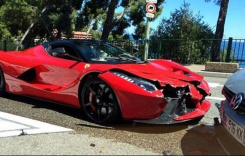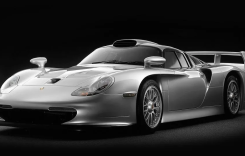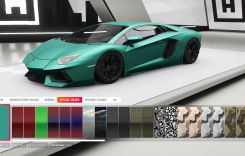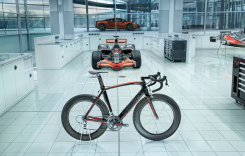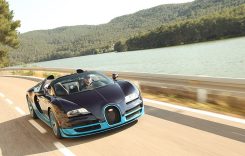Of the three new VT1300 Series motorcycles, the 2010 Sabre distinguishes itself as the most purebred boulevard cruiser of the trio with its pro-street styling. It starts with a longer stance than previous versions, with its lower frame rails skirting closer to the ground courtesy of a 70.0-inch wheelbase that is a full 4.5-inches longer than the old VTX. The 41mm fork is stretched out at a healthy 33-degree of rake, adding to its long and low appearance. The downtubes curve slightly in which allowed Honda to neatly tuck the slim-line radiator in between the rails, creating more space between the frame and front wheel. The top radiator hose tucks neatly behind the front valve cover, a new innovation for the marque that it has patented. Above the radiator, the steering head has been opened up to create space between it, the tank, and the engine which adds to its pro-street style.
An easy way to distinguish the Sabre from its counterparts is by looking at its fenders which are cut shorter front and back. A glance at its front hoop helps identify it as well, as the Sabre rolls with a slim 90mm and tall 21-inch front wheel. Its handlebars also hug the tank tighter being both lower and narrower than the Stateline or Interstate. Its seat is also a touch slimmer.
This Sabre looked extra sharp decked out with some of the accessories Honda has ready for the new VT1300 cruisers.
The 4.4-gallon tank is stretched similarly to the Fury’s and features a chrome tank-mounted console. The big dial of the analog speedo is the focus of the console, but it also has an odometer, dual tripmeters, small turn signal indicator lights, high beam, a neutral indicator, oil pressure and coolant temp lights to go along with a digitally-displayed clock. The chrome housing is attractively styled, but the bike’s cockpit itself is very compact for my six-foot-frame and the dial sits well below my line of sight when riding, meaning glances at the speedo requires a momentary removal of my sight from the road ahead.
Dual chromed exhausts streak down its right side while the driveshaft on the left sports a slim-profile. There’s no jacking of the driveshaft, instead power delivery to the rear wheel is constant and smooth. With no chain or belt guards present, it opens up the backside view of Honda’s new five-spoke design wheel. A 170mm wide, 15-inch tall Bridgestone graces the back and provides a grippy interface with the road.
Hiking a leg over the 26.9-inch seat height of the 2010 Sabre and thumbing the starter, the dual exhausts spark to life with a surprisingly aggressive growl. Pulling in the clutch and kicking it into gear, the clutch draw is light and rider-friendly and the five-speed transmission clicks easily into first. Rolling on the throttle, there’s plenty of immediate low-end pull and a meaty midrange that propels the bike up to just over 40 mph. Larger displacement bikes I’ve ridden sign
2010 Honda Sabre Specs

Engine – 1312cc liquid-cooled 52° V-twin
Bore/Stroke – 89.5mm x 104.3mm
Compression Ratio – 9.2:1
Induction – PGM-FI with automatic enrichment circuit, one 38mm throttle body
Ignition – Digital with 3-D mapping, two spark plugs per cylinder
Valve Train – SOHC; three valves per cylinder
Transmission – Five-speed
Final Drive – Shaft
Front Suspension – 41mm fork; 4.0 in. travel
Rear Suspension – Single shock; 3.9 in. travel
Front Brake – Single 336mm disc with twin-piston caliper
Rear Brake – 296mm disc with single-piston caliper
Front Tire – 90/90-21
Rear Tire – 170/80-15
Wheelbase – 70.0 in.
Seat Height – 26.9 in.
Curb Weight – 659 lbs (claimed wet weight)
Rake – 33° (Caster Angle)
Trail – 4.6 in.
Fuel Capacity – 4.4 gallons
off in about the same range. The one shortcoming of an otherwise generous powerband is the lack of much power on the top end. Running through the gears, the five-speed tranny is well-sorted and shifting is smoother than American V-Twins. Fifth gear will get you into about the 85 mph range and by then the bike is approaching the rev limiter and doesn’t have much more to give. Of course, by then you’re exceeding the limit and these bikes aren’t built for breaking the century mark, so the power supply is more than suitable for a mid-sized cruiser.
The bars sweep back and are in close. Team that with a foot controls that are comfortably within reach and the ergos position me leaning slightly forward with my arms tucked close to my body. The foot control for the rear brake is placed low and close to the foot peg and makes it difficult to find a safe riding position while wearing thick-toed boots. The forward lean of the riding position and narrow bars minimize the amount of bar action required to get the bike initiated in turns. The big 21-inch wheel tracks well enough in turns, but its fairly light unsprung weight does give the front end a little play on uneven surfaces.
Honda has been busy expanding its lineup of accessories for its VT1300 Series, and the Sabre’s $11,799 MSRP should leave riders with a little change in their pockets to pursue customization. Honda showcased some of the 48 products available for the series on a Sabre that sported chrome engine guards, a leather studded tank belt, a lower cowl
The bars on the Sabre are lower and in tighter in comparison to the bars on the Interstate and Stateline.
spoiler and sharp-looking chrome-plated custom grips (a first for the company). ABS is also an option, for an even $1000 more, which still keeps it below Honda’s magical $13,000 price point. Honda also claims the bike gets an attractive 47 mpg, but we didn’t have much opportunity to test the claim in our brief 130-mile ride.

